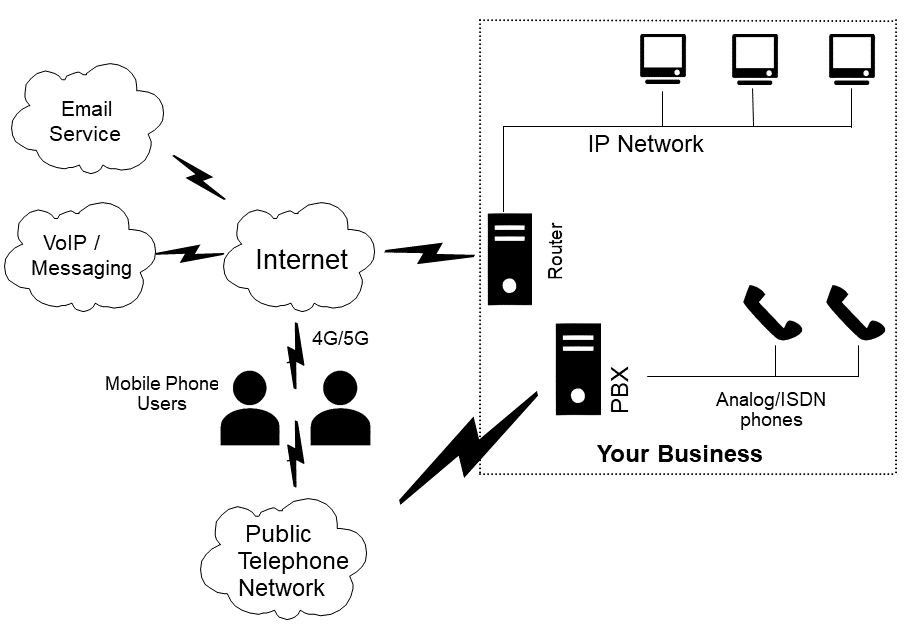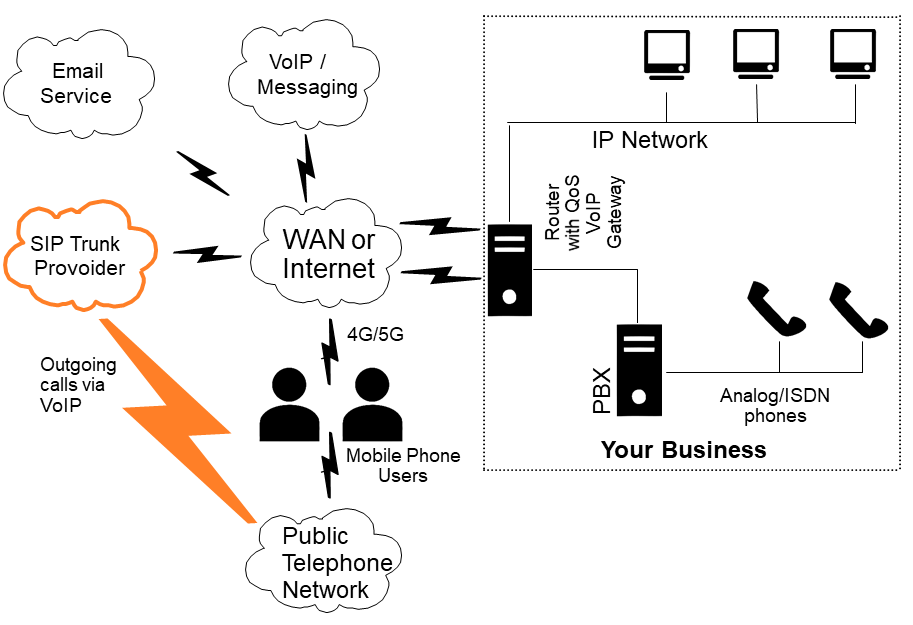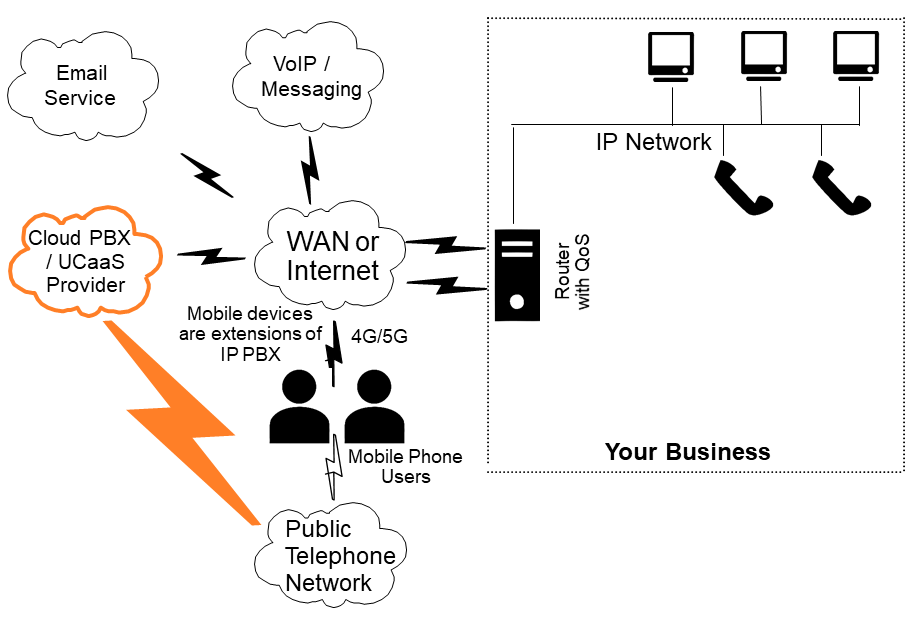Our SIP Trunking Services for Small and Medium Businesses (South Africa)
Our SIP trunking services allow you as a South African small or medium business (SME) to connect your Private Branch Exchange (PBX) to the Public Switched Telephone Network (PSTN) via an Internet Telephony Service Provider (ITSP).
Unlike traditional phone lines, which are limited in scalability and geographic reach, SIP trunks utilize an internet connection to carry voice data, offering flexibility, scalability, and cost-efficiency.
An onsite PBX connected to the PSTN via traditional telephone lines may be represented as:

- This shows the onsite legacy PBX connected to the PSTN via traditional trunks.
- There is a separate IP network which connects to the Internet and Cloud services such as Email and VoIP / Messaging (e.g. Skype and WhatsApp).
- Mobile phone users connect to the PSTN via their mobile provider and can also access the Internet via their data connections.
Once SIP trunking has replaced the traditional telephone lines, the position is:
- This shows the onsite legacy PBX connected to the PSTN via an onsite VoIP gateway which in turn connects to the Internet and a SIP trunk provider using SIP trunks.
- Redundant SIP trunks may be in place to minimise downtime. Redundancy may also be provided by connecting the VoIP gateway to the traditional PSTN.
- The Internet connection continues to connect to Cloud services such as Email and VoIP / Messaging.
- Mobile phone users continue to connect to the PSTN via their mobile provider and access the Internet via their data connections.

Benefits of SIP Trunking vs Traditional Phone Lines (PSTN) for SMEs
SIP trunking allows you a cost-effective migration to a Cloud PBX or Unified Communications service over time without having to ‘rip and replace’ your existing investments in legacy PBX infrastructure before your legacy PBX has reached end of life.
In addition to allowing you a cost-effective migration pathway to a Cloud PBX or Unified Communications service, a comparison of SIP trunking with traditional phone lines shows that SIP trunking offers you numerous benefits from inception. These include:

- Cost Savings. SIP trunking significantly reduces communication expenses by eliminating the need for multiple costly physical phone lines. It consolidates voice and data into a single network, minimizing maintenance, hardware, and long-distance call expenses. Businesses can also benefit from competitive per-minute rates and reduced international calling costs
- Scalability and Flexibility. SIP trunking allows your business to easily scale up or down your communication channels based on demand, without the constraints of physical infrastructure. Adding or removing lines is a simple process that can be done virtually, offering the flexibility to adapt to changing business needs quickly
- Geographic Flexibility. SIP trunking enables your business to establish a local presence in multiple regions without having physical offices. By acquiring local phone numbers from various locations, your company can cater to customers in different areas, enhancing your global reach and customer service
- Disaster Recovery and Business Continuity. In the event of a disaster or outage, SIP trunking ensures business continuity. Calls can be rerouted to alternative locations or devices, minimizing disruptions and ensuring uninterrupted communication
- Unified Communications Integration. SIP trunking seamlessly integrates with platforms, such as Microsoft Teams, allowing for the convergence of voice, video, messaging, and collaboration tools within a single platform, enhancing productivity and efficiency
- Enhanced Features and Functionality. SIP trunking offers a wide range of features beyond traditional telephony, including video conferencing, instant messaging, call forwarding, and presence indicators. These functionalities enhance communication and collaboration among employees and with clients.
SIP Trunking vs Cloud PBX or Unified Communications as a Service (UCaaS)
The diagram below shows the position when telephony services are being provided via a Cloud PBX or Unified Communications service:
- The onsite legacy PBX and its extensions are now removed
- The analogue telephones connect to the IP network via analogue telephone adaptors (ATAs) or are replaced by IP phones
- Real-time communications are prioritised using a QoS (quality of Service) enabled router
- Some unified communications services include the provision of email
- Software applications are installed on mobile phones to allow them to be used as extensions of the Cloud IP PBX / UCaaS.

A comparison between SIP Trunking Services and Cloud IP PBX for Businesses summarises the above:
SIP Trunking
- Continue to use your existing onsite legacy PBX and telephone extensions
- Maintain two separate networks onsite (analogue phone and IP)
- Difficult to scale because of the legacy PBX component
- Moves, adds and changes (MACs) can be expensive
- Less flexible than Cloud IP PBX services
- Monthly subscription cheaper than those for Cloud IP PBX
- Offers migration pathway to Cloud IP PBX or Unified Communications service (UCaaS)
Cloud IP PBX
- Onsite legacy PBX is no longer used
- Maintain one network onsite (IP)
- Use IP phones for extensions (hard or software applications including on mobile devices)
- Easily scalable according to requirements
- Easy to undertake MACs (moves, adds and changes)
- Offers a lot of flexibility
- Monthly subscriptions more expensive than SIP trunking
- Offers migration pathway to Unified Communications service (UCaaS)
SIP Trunking – A Strategic Alternative for Cost-Effective Business Phone Lines for SMEs
SIP trunking represents a transformative technology that empowers your business to improve communications, reduce call costs, improve flexibility, and enhance productivity. Its ability to converge voice, data, and multimedia into a unified platform makes it a vital asset for modern businesses seeking efficient and scalable communication solutions. As technology advances, the adoption of SIP trunking continues to be a strategic move for organizations aiming to stay competitive and agile in a rapidly evolving business landscape.
For more information on our SIP trunking service for South African businesses, please contact us.
Click on the link for more information on the value proposition our unified communications services offer you as a Business.
